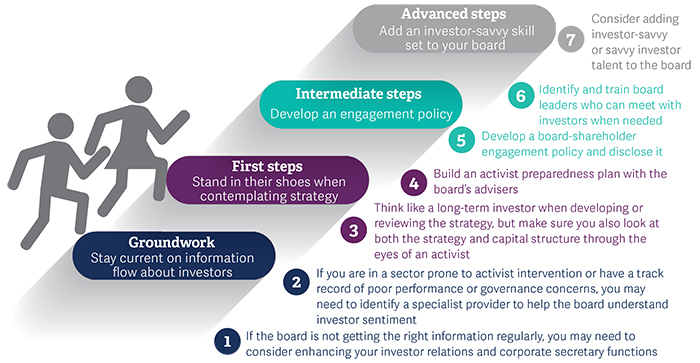Anthony Goodman is a member of the Board Effectiveness Practice at Russell Reynolds Associates. This post is based on an Russell Reynolds publication authored by Mr. Goodman, Jack “Rusty” O’Kelley, III, and Constantine Alexandrakis.
With mounting activist pressure and the increasing “activation” of large institutional investors continuing to transform corporate governance in the United States and many markets around the world, boards have had no choice but to become more investor savvy.
We have seen this trend firsthand in our work with boards, as well as in conversations with institutional investors. The most forward-thinking boards are doing what it takes to thrive in the new environment.
What can a board do to become more investor savvy? There are seven steps to consider, which we’ve ordered from basic to most challenging. Many boards are already making significant progress along this continuum. How does your board measure up?
Seven Steps to an Investor-Savvy Board
Groundwork: Stay current on information flow about investors
Most boards make sure they get regular updates (quarterly or semiannually) on investor sentiment from investor relations, the corporate secretary, or the CFO. Boards are keen to learn how they are seen by corporate governance and ESG ratings companies, whose reports are read closely by their institutional investors. Investor-savvy boards also make sure they understand where institutional investors stand on key issues for the proxy season. Directors can ask about the time horizon of their largest investors and focus on those with a long-term orientation. The largest institutions, such as BlackRock and Vanguard, publish their corporate governance guidelines and regularly report on their policies and engagements.
Key Actions
1. If the board is not getting the right information regularly, you may need to consider enhancing your investor relations and corporate secretary functions.
2. If you are in a sector prone to activist intervention or have a track record of poor performance or governance concerns, you may need to identify a specialist provider to help the board understand investor sentiment.
First steps: Stand in their shoes when contemplating strategy
Increasingly, boards are being asked to think like investors when it comes to reviewing company strategy. Of course, not all investors think alike: the board should focus its efforts on long-term, institutional investors. In 2015, organizations as diverse as the Conference Board, McKinsey & Company, and the Canadian Pension Plan Investment Board urged more long-term thinking. But as an insurance policy, it’s wise also to identify any vulnerabilities and imagine what different types of investors, including a short-term activist, would say about the strategy. What weaknesses would they identify? Boards should plan ahead with their advisers so they are prepared to deal with any unwelcome activist interventions.
Key Actions
3. Think like a long-term investor when developing or reviewing the strategy, but make sure you also look at both the strategy and capital structure through the eyes of an activist.
4. Build an activist preparedness plan with the board’s advisers.
Intermediate steps: Develop an engagement policy
Many of the largest and most significant institutional investors are demanding direct access to members of the board. A board’s first step in response should be to develop a policy on when and with whom it will engage. Boards are not under any obligation to accept every invitation. Nor should boards issue invitations unless there is a mutually compelling reason to meet. Aimless engagement wastes everyone’s time.
The board then needs to decide which directors have the skills and experience to engage with investors. Often, engagement falls to current or retired CEOs and CFOs. Investors want to meet with a director who can best articulate how the board works and how it collaborates with management, someone who can listen and channel feedback in an objective and accurate way. By role, investors typically want to meet with the independent, non-executive chair, the lead director and/or the chairs of the key committees. Depending on the agenda and the wishes of investors, the company CEO may not be present. Sometimes, the general counsel or someone from investor relations will sit in to help with advice, Reg FD guidance and note taking, but they may not have a primary speaking role—which makes it all the more necessary that the participating directors be investor savvy.
When the board has a set policy on engagement, it makes sense to disclose it on the company website or—better still—in the proxy.
Key Actions
5. Develop a board-shareholder engagement policy and disclose it.
6. Identify and train board leaders who can meet with investors when needed.
Advanced Steps: Add an Investor-Savvy Skill Set to Your Board
Some boards discover that they do not have enough investor-savvy directors who can be available for engagement with investors. One way to address that gap is by adding directors with experience dealing with investors on a day-to-day basis. Another way may be to proactively add savvy investors themselves.
Key Actions
7. Consider adding investor-savvy or savvy investor talent to the board.
Several leading companies have appointed directors with the explicit aim of improving their board’s investor-savviness. When Rodger Lawson, former CEO of Fidelity, was added to the board of UnitedHealth Group, Richard Burke, the board chairman, acknowledged that the board would benefit from Lawson’s “ability to provide a deeper understanding of the perspectives and priorities of institutional investors.”
When Jack Brennan, former chairman of Vanguard, was appointed to the General Electric board, CEO Jeff Immelt made it clear that Brennan’s understanding of the shareholder perspective was instrumental in the decision:
“Jack knows what shareholders care about and what good governance looks like,” Mr. Immelt said in a statement immediately after Brennan’s appointment.
More recent investor-savvy appointees include former T. Rowe Price CEO Jim Kennedy to the United Airlines board and veteran hedge fund investor Scott Daniels to the Carbonite board. Mohamad Ali, president and CEO of Carbonite, said on Mr. Daniels’ appointment, “Scott brings valuable experience in public equities investment and capital markets to our board of directors.”
 Print
Print